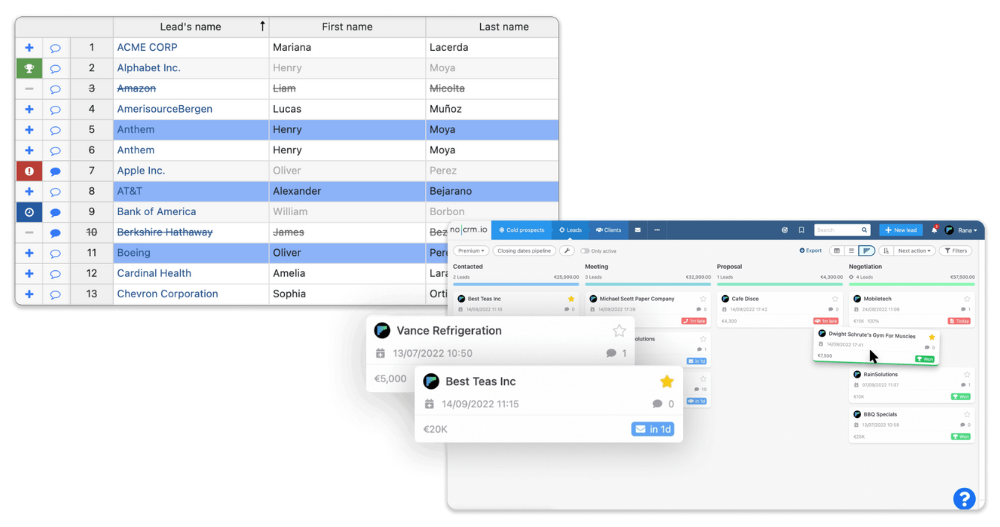
Building a prospecting table on Excel enables one to define their objectives, the information needed, and the commercial actions necessary to achieve such objectives. A prospecting table also helps prioritize leads and prospects.
For all of these reasons, this tool is essential. However, its construction and follow-up may be time-consuming. Using software and tools overcoming the limitations of Excel may help make the process all the more efficient.
What is a prospecting table?
The information on a prospecting table
A prospecting table is a file centralizing all the information and contact details of targeted prospects. It may be more or less complete depending upon your needs.
All data may be classified by category or by sector of activity. Amongst other, the following elements must be included in a prospecting table:
- The sector of activity;
- The company;
- First and last name of the contact person;
- Their position held;
- Their telephone number;
- Their email address;
- Key information about their business;
- Link to their website.

It is also a tool for constant monitoring of current and potential customers. This pretty time-consuming tracking may be optimized using tools, further detailed in this article.
Using a prospecting table
A prospecting table enables easier monitoring of your prospecting. As such, you may add a column dedicated to the prospecting’s tracking and follow-up. Each salesperson can add information after exchanges with the prospect, according to the results obtained.
Company’s undertaking telephone or email prospecting often use CRM to collect and sort information. However, this is not always appropriate, and especially as prospecting activities grow.
For salespeople using an Excel prospecting table, it is essential to know all about the software’s advanced options and features. This makes it easier and faster to search and sort data.
Free Excel prospecting table
To help you set up your Excel prospecting table, you can download our free template here.
How to create a prospecting table with Excel
Defining your objectives
Before you start entering data into your Excel spreadsheet, you need to properly define the objectives you have for this document.
Having a general vision of what you expect from your Excel prospecting table generally allows you to make sure not to forget anything.
Amongst others, think about the following questions:
- What do you want to achieve from your prospecting?
- How advanced are you in the process as of now?
- How much time are you allocating to achieve your objectives?
Defining key information
Now that your aims are clearly defined, you must define the key information needed about your prospects and customers. Generally, the following information is to be filled out in the Excel file:
- Company name and size;
- The sector of activity;
- Contact and contact details;
- Source – where the prospect came from (social networks, etc.).
Remain flexible in your information gathering, and do not hesitate to add any additional useful data about your customers or prospects. Several templates are available on the internet, but they should always be adapted to your hands-on needs.
A “comments” column is always welcome to store all the information obtained during previous calls or meetings. Many salespeople may work on this document, hence everyone should be able to follow others’ work and progress.
Define the necessary sales actions
The Excel prospecting table is not simply a list of information about customers and prospects. This file is also a document for monitoring the commercial actions previously carried out and to be carried out in the future.
Columns should show previous actions: first call, follow-up email, second call, etc. You may also enter the date on which they took place, or are due to take place.
By listing sales actions, salespeople keep track of all the key stages of canvassing and have a clear vision of their progress. The prospecting status may also be shared to colleagues.
Prioritizing your leads and prospects
Always keep in mind that this file is your prospecting follow-up or tracking tool. When consulting it, you must know the contact’s status at a glance (cold prospect, half-hearted prospects, or interested lead). More importantly, this information will allow any salesperson to prioritize actions according to the potential, urgency or importance of the customer or prospect.
In order to prioritize information, you may use a scoring system to show the degree of prioritization of certain prospects or customers. A prospect’s potential is often quantified by a percentage, symbolizing its progress throughout the prospecting process.
This column must be continually updated, along with all other information contained in the file. If not, you run the risk of duplicating or missing certain commercial actions.
Boosting your prospecting table and your sales
The limitations of Excel
Although the Excel prospecting table is a suitable tool for small companies, it isn’t generally suitable for larger-scale prospecting, the latter requiring very precise and daily follow-up. In addition, attachments cannot be added to an Excel file.
Once the first stages of prospecting are over, a traditional Excel file does not allow the prospect to be transferred to a more suitable tool for reminders, sales stages, etc. It is therefore more complex for sales representatives to keep track of all the actions’ chronology.
Furthermore, Excel only provides raw data, without commercial analysis or statistics. Some other tools exploit the information contained in the table to provide an in-depth reading of the state of progress and next steps.
Replacing Excel with CRM
You may need an integrated online spreadsheet, which is similar to Excel, but more comprehensive so you don’t have to work on various different tools.
Although most CRM (Customer Relationship Management) tools enable this, we find that most of them are not suited for salespeople who do not use all features. Smaller companies are confused by the complexity of CRMs and still prefer to use Excel, thus limiting their potential.
The advantages of noCRM
Faced with the shortcomings of Excel and the complexities of CRM tools, many companies – and especially start-ups and SMEs – are now turning to lead management softwares.
noCRM is a simple software that has all the advanced options you need for your prospecting. This tool will enable you to directly work on your spreadsheet and help turn prospects into leads, following up all actions in the process.
The software has a very intuitive dashboard guaranteeing effective and personalized follow-up. Built on the simplicity of Excel, noCRM adds an analytical function to your data. It will help your strategy evolve, confirm your choices or optimize your future actions.
Amongst the software’s features, the following are particularly interesting:
- Creating leads in just a few seconds;
- Planning future actions;
- Automating certain tasks.

Please also note that lead management softwares such as noCRM works in SaaS mode (software as a service). There is also a mobile application. Wherever you are, you can instantly follow your progress and schedule the next steps.
Don’t hesitate to ask for a free software trial, to see which of the three price options is best suited to your needs. Make up your own mind, see for yourself, and save yourself some precious time!
Conclusion
Using a prospecting table allows each salesperson to manage their activities by prioritizing high-potential prospects more easily. Collecting and sorting key prospect and customer data allows every salesperson to track their progress by recording all existing discussions and previously taken actions.
The classical Excel prospecting spreadsheet can do this, but using additional tools optimizes prospecting to help make it swifter and more efficient.
Although CRMs fill some of Excel’s deficiencies, they may sometimes be too complex.
noCRM as a follow-up software provides you with all the advanced options you need, while remaining simple and accessible. Try it for free now.
FAQ
An Excel prospecting table lists and centralizes all the information that a company needs about its prospects.
To build an Excel prospecting table, you need to define your objectives, the key information you need, the commercial actions to be implemented and the methods for prioritizing prospects.
Excel prospecting tables are not suited for large-scale prospecting, do not allow for the inclusion of all documents and attachments in the same file and do not facilitate simplified follow-up on a single document.



